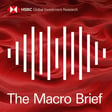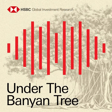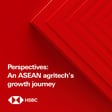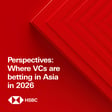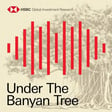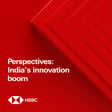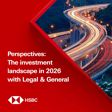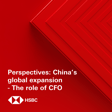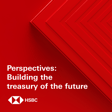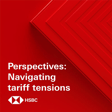Become a Creator today!Start creating today - Share your story with the world!
Start for free
00:00:00
00:00:01

Under the Banyan Tree - An economic tour of ASEAN
From factory relocations to tourism and exotic fruit exports, Herald van der Linde sits down with ASEAN Economists Yun Liu and Aris Dacanay to discuss the key themes shaping ASEAN’s disparate economic landscape. Disclaimer: https://www.research.hsbc.com/R/51/JwJWSxR Stay connected and access free to view reports and videos from HSBC Global Research follow us on LinkedIn https://www.linkedin.com/feed/hashtag/hsbcresearch/ or click here: https://www.gbm.hsbc.com/insights/global-research.
Hosted on Acast. See acast.com/privacy for more information.
Transcript
Introduction to HSBC Global Viewpoint Podcast
00:00:00
Speaker
Welcome to HSBC Global Viewpoint, the podcast series that brings together business leaders and industry experts to explore the latest global insights, trends, and opportunities.
00:00:11
Speaker
Make sure you're subscribed to stay up to date with new episodes.
00:00:14
Speaker
Thanks for listening, and now on to today's show.
00:00:16
Speaker
This is a podcast from HSBC Global Research, available on Apple Podcasts and Spotify.
00:00:22
Speaker
However you're listening, analyst notifications, disclosures, and disclaimers must be viewed on the link attached to your media player.
Under the Banyan Tree: ASEAN Focus
00:00:38
Speaker
Welcome to Under the Banyan Tree, where we put Asian markets and economics in context.
00:00:44
Speaker
I'm your host, Harold van der Linde, head of Asia Equity Strategy at HSBC.
00:00:50
Speaker
On today's podcast, we're taking you on a whistle-stop tour across the ASEAN economies, which are commanding more and more investor attention, particularly as an alternative to mainland China.
00:01:01
Speaker
With me in the studio are ASEAN economists Yun Liu and Aris Dagenij.
Overview of ASEAN Economic Landscape
00:01:06
Speaker
ASEAN is home to 600 million people across 4.5 million square kilometers, so we've got a lot of ground to cover.
00:01:14
Speaker
Let's get the conversation started right here, under the banyan tree.
00:01:27
Speaker
A little background context to begin with.
00:01:30
Speaker
ASEAN is a collection of 10 economies across Southeast Asia with a total GDP in a region of $3 trillion per year.
00:01:37
Speaker
It's a disparate economic landscape, from the factories of Vietnam to the bright lights of Singapore's financial district.
00:01:45
Speaker
And like everywhere else, challenges around inflation and the post-COVID recovery has hit the ASEAN economies to a varying extent.
Vietnam's Trade and Property Market Challenges
00:01:52
Speaker
Trade, manufacturing, foreign investments, they're all big themes for these economies.
00:01:57
Speaker
Jun, let's kick off with Vietnam.
00:01:59
Speaker
You've been looking at that for a couple of years now.
00:02:01
Speaker
The story with Vietnam was all the supply chains that came out of, or the factories that came out of China, and they were moving predominantly to Vietnam.
00:02:10
Speaker
It was a great growth story, but somehow I got the impression it got a little bit stuck in the mud, right, Vietnam?
00:02:15
Speaker
What's going on there?
00:02:16
Speaker
Yeah, that's true.
00:02:17
Speaker
So Vietnam has been facing quite a lot of trade challenges since last quarter of 2022.
00:02:22
Speaker
And if we look at its export numbers, it declined by double digits, although now we're seeing a little bit of stabilization, but Vietnam is not out of the woods yet.
00:02:31
Speaker
But I guess, you know, one part of the resilience that we're seeing in Vietnam is that FDI still remains decent.
00:02:37
Speaker
Investments, right?
00:02:38
Speaker
So foreign investors are still going in there, building up factories.
00:02:41
Speaker
That's right, because FDI reflects a medium to long term perspective, whereas we're now facing some near term challenges on the trade.
00:02:48
Speaker
But where's this trade weakness then coming from?
00:02:50
Speaker
Because they're setting up the factories, you think they'll export all that stuff around the world.
00:02:54
Speaker
So it started with the electronic cycle, but then it really has broadened to different other sectors, you know, textile, foodware.
00:03:01
Speaker
machinery, a lot of the products that Vietnam produces, mainly because of falling orders from the West.
00:03:07
Speaker
I mean, of course, you know, part of the story is because of the structural changes after the pandemic eases, the demand for goods has waned.
00:03:15
Speaker
We're not going to see the same sort of demand that we saw.
00:03:18
Speaker
So it's not really a Vietnam issue, it's kind of a global issue.
00:03:20
Speaker
That's correct.
00:03:20
Speaker
Demand is a bit weaker.
00:03:21
Speaker
That's right.
00:03:22
Speaker
They're struggling with that.
00:03:23
Speaker
They also have some problems, I think, with the property sector there, right?
00:03:25
Speaker
That's right, yeah.
00:03:26
Speaker
So Vietnam's property market has been facing some challenges, started with some liquidity issues.
00:03:31
Speaker
But the good thing is that the government has been proactively addressing some of the issues with credit package.
00:03:38
Speaker
So hopefully we can see some stabilization in the sector.
Philippines Economic Growth and Inflation Issues
00:03:41
Speaker
Well, that would be good, in particular for equities, because we've seen the stock market come off quite a lot.
00:03:45
Speaker
Let's fly over to the next ASEAN country, and that's the Philippines.
00:03:50
Speaker
Irish, you're a Filipino.
00:03:52
Speaker
Yes.
00:03:53
Speaker
What's going on there?
00:03:53
Speaker
I read about unbalanced growth, food inflation.
00:03:57
Speaker
Give me a quick rundown.
00:03:58
Speaker
What's going on?
00:03:58
Speaker
So actually, I guess to start things off, the Philippines has experienced in 2022 and even in the first quarter of 2023, very, very impressive growth.
00:04:07
Speaker
We grew above 7%, the highest in the past 40 years.
00:04:10
Speaker
And it's quite boggling in a way that we do have the highest inflation rate in ASEAN.
00:04:16
Speaker
We also raised rates most aggressively across ASEAN.
00:04:19
Speaker
So what's really fueling this growth?
00:04:22
Speaker
What's fueling this growth are people being very resilient, dipping into their savings to get by the very hard times, to get by the pandemic, to get by high inflation.
00:04:32
Speaker
So how much can savings last?
00:04:34
Speaker
You can't dip into your savings forever.
00:04:37
Speaker
You gotta have to build your savings back up.
00:04:39
Speaker
So you think that consumption is going to come under pressure?
00:04:41
Speaker
Yes, we do think that consumption will eventually need to slow down, to cool, to return the economy back to balance.
00:04:50
Speaker
Just quickly, so it's a consumption story, but one of the issues, I guess, in the Philippines that everybody's talking about taking factories and building them up in ASEAN and India, right?
00:05:00
Speaker
And they're talking about Vietnam, they're talking about Thailand, they're talking about Malaysia, they're talking about Indonesia.
00:05:04
Speaker
Nobody goes really to the Philippines, right?
00:05:06
Speaker
The FDI, the foreign investment levels are somewhat lower.
00:05:09
Speaker
Well, I do think it's underrated in a way that if you look at FDI as a percent of GDP, the Philippines is actually in the middle of the pack.
00:05:18
Speaker
Okay.
00:05:35
Speaker
I myself will need to buy something in the Philippines if I do want to raise a family in the years ahead.
00:05:41
Speaker
So you do have a lot of very consumer-related FDI flowing into the Philippines as of late.
Thailand's Economic Hurdles and Export Success
00:05:48
Speaker
This maybe brings us to the next country.
00:05:49
Speaker
So let's go to Thailand because Thailand was the favorite investment destination in the 90s and the early 2000s.
00:05:57
Speaker
But now that's much less so.
00:05:59
Speaker
It's still there, of course.
00:06:00
Speaker
But Vietnam, people talk about the Philippines, they say more for consumer-related stuff.
00:06:06
Speaker
What's going on in Thailand?
00:06:07
Speaker
And of course, also touch maybe quickly upon, for example, tourism because it's a tourism place, right?
00:06:12
Speaker
So for example, I mean, just to relate it to the Philippines with a very favorable demographic trend, Thailand does not.
00:06:20
Speaker
Thailand will soon have a declining demographic trend.
00:06:22
Speaker
So that market base that people are looking for, it's not going to be as big in the years ahead.
00:06:28
Speaker
You also have high household debt.
00:06:31
Speaker
Household debt is around 90% of GDP today.
00:06:34
Speaker
So it's hard to get that consumer market.
00:06:37
Speaker
Now, if you're a person investing from abroad, going to Thailand, it's really hard to sell domestically.
00:06:42
Speaker
But I do think what they're trying to bank on is actually to bring in more people from abroad and relying and investing on tourism to actually keep the economy going.
00:06:51
Speaker
But so far, tourism, and that's really mainland Chinese tourists that's supposed to come, right?
00:06:56
Speaker
That's the big one.
00:06:57
Speaker
Has kind of not really lived up to the expectations, right?
00:07:01
Speaker
Maybe it comes in a later year?
00:07:03
Speaker
For 2022 and 2023, everyone was banking on this big tourism boom for Thailand, which will bring the economy above pre-pandemic levels, which it already has, but just by a meager amount.
00:07:14
Speaker
But nonetheless, it was expecting this boom.
00:07:17
Speaker
Now, the question is, how big is that boom?
00:07:19
Speaker
It's not as booming as people expected it to be.
00:07:22
Speaker
And that's because mainland Chinese tourists are not returning as what everyone expected it to be.
00:07:28
Speaker
It has plateaued at around 36% of pre-pandemic levels.
00:07:31
Speaker
And we have yet to see whether the Chinese will arrive.
00:07:35
Speaker
Everyone thought it was a supply issue.
00:07:37
Speaker
But it turns out it's really not.
00:07:39
Speaker
Maybe that's because Chinese New Year, they went back home to see their families first after COVID, right?
00:07:44
Speaker
And then maybe a bit of domestic travel is easier.
00:07:47
Speaker
And maybe it takes time.
00:07:49
Speaker
We'll have to see.
00:07:50
Speaker
I guess one fact that I just want to bring in is the fact that flight capacity as a percent of pre-pandemic levels is actually above the tourist arrivals.
00:07:58
Speaker
So it just goes to show that it's more of a demand issue.
00:08:01
Speaker
You can get a flight.
00:08:02
Speaker
Yeah.
00:08:03
Speaker
So one bright spot in Thailand is the export of durian, right?
00:08:08
Speaker
That spiky, large, extremely smelly tropical fruit.
00:08:12
Speaker
And either people hate it or love it.
00:08:15
Speaker
I'm in the love camp, but I remember Fred in the previous podcast, which was about this.
00:08:19
Speaker
Fred said it's not something that he can eat.
00:08:21
Speaker
But that seems to be, there seems to be a craze fruit from China, right?
00:08:24
Speaker
I like it frozen.
00:08:26
Speaker
I don't know how you like it.
00:08:27
Speaker
No, no, I like it.
00:08:28
Speaker
I like it.
00:08:28
Speaker
But for mainland China, they like it as a, they give it to their girlfriend.
00:08:33
Speaker
They give it to their partners as a sign of love.
00:08:36
Speaker
And that raised this like craze in China right now that around 1 to 3% of China trade or China exports from Thailand to China was durian.
00:08:46
Speaker
Now it has boomed to 15%.
00:08:47
Speaker
So it's like, it's as big as like electronics or oil or something like that.
00:08:52
Speaker
Well, it's not as big as electronics just yet.
00:08:54
Speaker
It's a big thing, but I guess just to put some size into it, Thailand is the second largest exporter of rice.
00:09:02
Speaker
Durian has exceeded rice.
00:09:04
Speaker
That's how big the number is.
00:09:05
Speaker
Durian is bigger than rice.
00:09:06
Speaker
Yes.
00:09:07
Speaker
Good.
00:09:08
Speaker
Let's now go a little bit further south.
00:09:09
Speaker
Yun, Malaysia.
00:09:10
Speaker
So do we see foreign investments still coming in in Malaysia?
00:09:13
Speaker
Oh, definitely.
00:09:14
Speaker
So if we look at FDI as a percentage of GDP, Malaysia has been topping the ASEAN region.
00:09:20
Speaker
And Malaysia has been getting a lot of the investment, actually broad-based investment.
00:09:24
Speaker
That's semiconductors.
00:09:25
Speaker
Semiconductor is definitely one.
00:09:27
Speaker
And a lot of the advanced semiconductor investment from the US, from Europe.
00:09:32
Speaker
But Malaysia has been gaining a lot of FDI share from China as well.
00:09:36
Speaker
But they're...
00:09:37
Speaker
Trade has softened as well, right?
00:09:38
Speaker
A bit like the Vietnam story.
00:09:40
Speaker
That's right.
00:09:40
Speaker
But Malaysia, so Malaysia is not immune to the global trade challenges.
00:09:45
Speaker
But if we look at its exports, it has remained resilient, more resilient than other countries.
00:09:51
Speaker
Malaysia has gained substantial market share in particular semiconductors.
Malaysia's FDI and Economic Growth Plan
00:09:54
Speaker
And a lot of the semiconductors are actually automotive chips.
00:09:59
Speaker
So the demand for automotive chips have remained more resilient than demand for, say, computers or smartphones.
00:10:05
Speaker
Okay, so a relatively better story in that sense.
00:10:08
Speaker
And also the new government has indicated some economic plan, right?
00:10:13
Speaker
That's correct.
00:10:14
Speaker
What's their idea in a nutshell?
00:10:16
Speaker
Yeah, so ANWR unveiled a very ambitious 10-year economic plan.
00:10:20
Speaker
And the main goal here is for Malaysia to revert back to its 6% growth, like before the Asian financial crisis.
00:10:29
Speaker
It has outlined a lot of the policies on FDI attraction, on infrastructure spending.
00:10:35
Speaker
So we're still waiting to see more details
Indonesia's Macroeconomic Stability and Future Prospects
00:10:37
Speaker
to be unveiled.
00:10:37
Speaker
Okay, 6% growth.
00:10:39
Speaker
That's where Vietnam is maybe a little bit lower, but Indonesia is 5% to 6%.
00:10:43
Speaker
That's where ASEAN is trending around, right?
00:10:45
Speaker
Some of the major countries in ASEAN, give or take.
00:10:47
Speaker
Good.
00:10:49
Speaker
And then Indonesia, that's of course the biggest one in Asia, right?
00:10:53
Speaker
By population, by anything.
00:10:55
Speaker
Again, it's battery makers coming in, the macro looks pretty good.
00:10:58
Speaker
I mean, it's really in a bright spot, that place, right?
00:11:01
Speaker
Yeah, and I think one thing about Indonesia that people need to know is the fact that it has been able to achieve macroeconomic stability the soonest across ASEAN.
00:11:11
Speaker
And I think it's because it's banking on its exports on EV batteries.
00:11:15
Speaker
So the current account deficit, which used to be around, I think, above 1% of GDP before, it's going to narrow down even further through the years ahead, giving some macroeconomic support and stability for EV.
00:11:27
Speaker
Basically, current account deficit means you need capital from the rest of the world or if you're in surplus, you're actually providing capital.
00:11:34
Speaker
Yes, so you're actually needing less capital from the rest of the world.
00:11:38
Speaker
And that actually gives Indonesia room to be able to cut rates earlier than everyone else across
Singapore's Economic Resilience and Tourism Recovery
00:11:45
Speaker
ASEAN.
00:11:45
Speaker
So our chief Indonesia economist has forecasted that the easing cycle will begin at the end of the year.
00:11:52
Speaker
Meaning in 2023, while for example in the Philippines, we forecast it to begin at maybe a third quarter of 2024.
00:12:00
Speaker
So that macroeconomic stability in Indonesia has been really good.
00:12:04
Speaker
That benefits everybody.
00:12:05
Speaker
No interest rates, not so much inflation and all these other things.
00:12:09
Speaker
Now very quickly on the last one and that's Singapore.
00:12:11
Speaker
It's one of the smallest ones but the most developed high income levels.
00:12:17
Speaker
What's going on?
00:12:18
Speaker
Travel seems to be weak in Thailand, but it's strong, I believe, in Singapore, right?
00:12:23
Speaker
Yeah, that's correct.
00:12:24
Speaker
So Singapore has very fortunately avoided a technical recession in the second quarter this year.
00:12:30
Speaker
While the trade challenges are pretty much similar to Vietnam is going through, but the travel sector actually still has a lot of momentum.
00:12:38
Speaker
And actually, in particular, the Chinese visitors' recovery is the highest in Singapore than, say, pure...
00:12:45
Speaker
tourism destinations.
00:12:46
Speaker
So they've gone there before Thailand.
00:12:47
Speaker
Yeah, so exactly.
00:12:48
Speaker
So Singapore, Malaysia and Vietnam, I think part of the reason is because a lot of the Chinese visitors going to these three markets are, more of them are business travelers.
00:12:57
Speaker
So there's a lot more interest in, say, for example, the business related activities or FDI than pure tourism.
00:13:04
Speaker
Very good.
ASEAN's FDI Inflows and Regional Stability
00:13:05
Speaker
We're going to take a quick break now.
00:13:07
Speaker
When we come back, we'll recap what we've discussed so far and we take a quick look at the equity markets in ASEAN.
00:13:24
Speaker
Joon, Aris, welcome back.
00:13:26
Speaker
So we've made this big tour across ASEAN.
00:13:29
Speaker
And broadly speaking, it seems that the story of FDI inflows in the region is still valid.
00:13:35
Speaker
It's just a different kind of sectors and industries.
00:13:38
Speaker
Trade is a bit weak, I think, right?
00:13:40
Speaker
Yeah, that's correct.
00:13:41
Speaker
I mean, for the trade challenges, we're still seeing that in countries like Vietnam, Singapore, well, to a certain extent in Malaysia as well.
00:13:47
Speaker
But the FDI story remains right.
00:13:49
Speaker
It's still there.
00:13:50
Speaker
So that's still the case.
00:13:52
Speaker
But the FDI story is just a bit different in the Philippines, it sounds like.
00:13:57
Speaker
Yeah, it's more consumer related.
00:13:59
Speaker
It's not those electronic semiconductors related FDI that you see in Malaysia, that you see in Thailand.
00:14:04
Speaker
Yeah.
00:14:05
Speaker
And Indonesia in a sense because they go into the electric vehicle industry there.
00:14:11
Speaker
But the overall story is that actually it allows ASEAN to hum along at about 5-6% GDP and it comes with inflows in the region that allows the currencies to strengthen.
00:14:23
Speaker
That means they don't have to raise interest rates as much or they can even start cutting interest rates across the region.
00:14:29
Speaker
And that effectively benefits everybody directly or indirectly, correct?
Investment Opportunities in ASEAN Equity Markets
00:14:34
Speaker
Yeah, that's absolutely right, Harold.
00:14:35
Speaker
This is the macro picture.
00:14:36
Speaker
But by the way, how about the equity market in ASEAN?
00:14:39
Speaker
Yeah, so the equity markets, you have to look at growth as well, of course.
00:14:42
Speaker
That's where we look at an interest rate.
00:14:44
Speaker
And so now we've spoken about this.
00:14:45
Speaker
But you have to look at position, for example, as well.
00:14:47
Speaker
We know, for example, a lot of funds at the moment are looking at Indonesia because of the interesting growth story there.
00:14:55
Speaker
But across the rest of the region, I think most funds, I'm talking about institutional funds that are investing in the region there, it's a bit more spotty.
00:15:03
Speaker
They pick the consumer market here, they pick the banks there and stuff.
00:15:06
Speaker
That's the approach.
00:15:07
Speaker
But generally speaking, optimism on ASEAN is great.
00:15:12
Speaker
It is combined a reasonably large equity market as well compared to China.
00:15:17
Speaker
That's just humongous, right?
00:15:19
Speaker
And Japan is really, really big.
00:15:21
Speaker
These markets are smaller, but if you clopper them all together, they become sizable enough.
00:15:27
Speaker
So you see that people say, oh, let me go for an Indonesian, maybe a company here, and then I'll buy a bit in Thailand, I'll buy a bit in the Philippines.
00:15:33
Speaker
So they spread that around.
00:15:35
Speaker
But broadly speaking, it follows very much the story that you've laid out here.
00:15:41
Speaker
And on that note, Yun, Aris, thank you very much for joining us on the Banyan Tree this week.
00:15:46
Speaker
Thank you very much for having us, Harold.
00:15:47
Speaker
Thank you, Harold.
Conclusion and Subscription Reminder
00:15:53
Speaker
And that brings us to the end of another edition of Under the Banyan Tree.
00:15:57
Speaker
We now have our own dedicated podcast channel on Apple Podcasts and Spotify, so be sure to subscribe there or wherever you get your podcasts.
00:16:06
Speaker
We'll be back again next week, putting Asian markets and economics in context.
00:16:10
Speaker
All the best till then.
00:16:17
Speaker
Thank you for joining us at HSBC Global Viewpoint.
00:16:20
Speaker
We hope you enjoyed the discussion.
00:16:22
Speaker
Make sure you're subscribed to stay up to date with new episodes.
